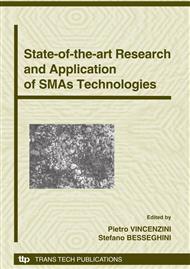p.129
p.135
p.140
p.150
p.156
p.162
p.168
p.178
p.184
Functional Properties of Ti-Ni-Based Shape Memory Alloys
Abstract:
The main functional properties (FP) of Ti-Ni Shape Memory Alloys (SMA) are their critical temperatures of martensitic transformations, their maximum completely recoverable strain (er,1 max) and maximum recovery stress (sr max). Control of the Ti-Ni-based SMA FP develops by forming well-developed dislocation substructures or ultrafine-grained structures using various modes of thermomechanical treatment (TMT), including severe plastic deformation (SPD). The present work shows that TMT, including SPD, under conditions of high pressure torsion (HPT), equal-channel angular pressing (ECAP) or severe cold rolling followed by post-deformation annealing (PDA), which creates nanocrystalline or submicrocrystalline structures, is more beneficial from SMA FP point of view than does traditional TMT creating well-developed dislocation substructure. ECAP and low-temperature TMT by cold rolling followed by PDA allows formation of submicrocrystalline or nanocrystalline structures with grain size from 20 to 300 nm in bulk, and long-size samples of Ti-50.0; 50.6; 50.7%Ni and Ti-47%Ni-3%Fe alloys. The best combination of FP: sr max =1400 MPa and er,1 max=8%, is reached in Ti-Ni SMA after LTMT with e=1.9 followed by annealing at 400°C which results in nanocrystalline (grain size of 50 to 80 nm) structure formation. Application of ultrafine-grained SMA results in decrease in metal consumption for various medical implants and devices based on shape memory and superelastiсity effects.
Info:
Periodical:
Pages:
156-161
Citation:
Online since:
September 2008
Price:
Сopyright:
© 2008 Trans Tech Publications Ltd. All Rights Reserved
Share:
Citation:


